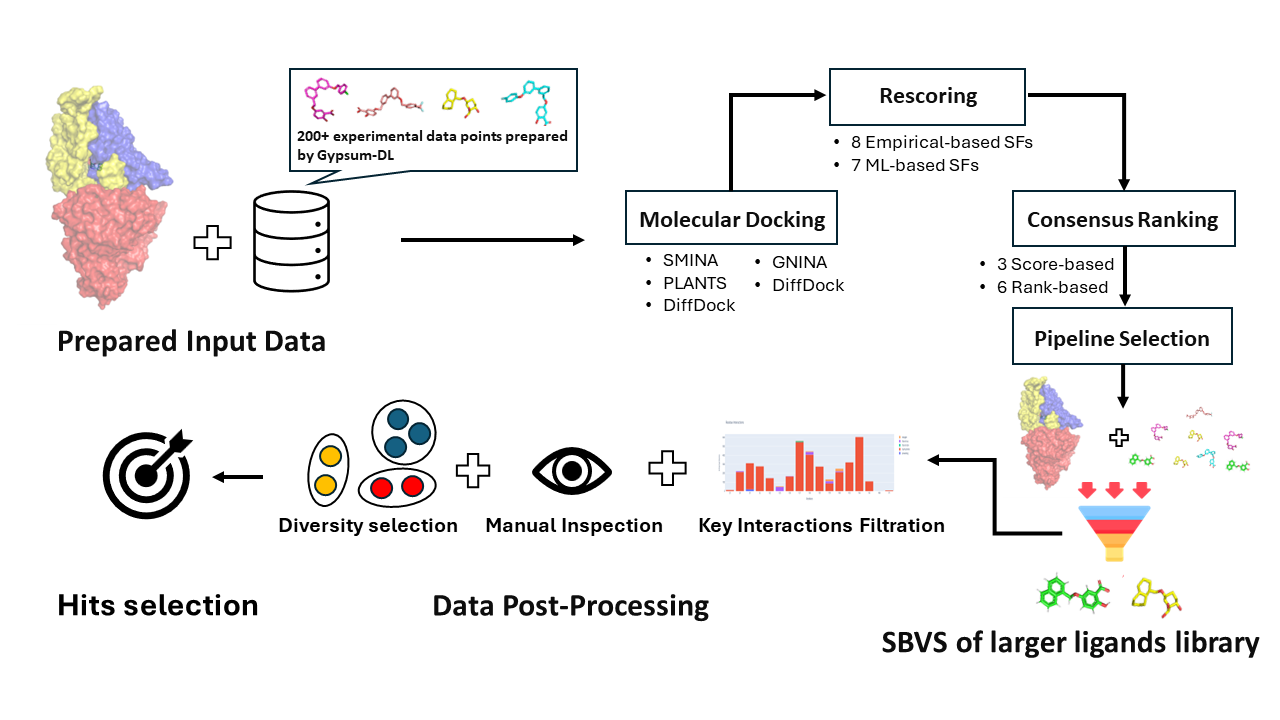MolDockLab is a data-driven workflow developed to identify the best balanced consensus Structure-Based Virtual Screening (SBVS) workflow for a target of interest.
The workflow integrates 5 docking tools, 15 scoring functions, and 9 consensus ranking methods to select the best balanced consensus SBVS for an experimentally-validated dataset.
Once selected, the workflow can be applied on larger ligands library The results are then filtered by either manually determining the key interactions or by automatically selecting the four most frequent interactions and choosing the most diverse compounds, achieving optimal screening performance for hit identification.
As a validation case study, the workflow was applied to the EGFR target (Epidermal Growth Factor Receptor) to compare different SBVS pipelines and assess their relative performance. Results can be found in egfr_data/.
MolDockLab was used in a real case study to find potential hits for an antibacterial tet called Energy Coupling Factor Transporters (ECF-T), in a collaboration work with Helmholtz-Institut für Pharmaceutical Research Saarland (HIPS). Through screening the in-house library of around 6.6K compounds, it resulted in the identification of two new antibacterial classes for ECF-T target, which were validated experimentally.
egfr_data/: Directory contains the EGFR-specific data used in the MolDockLab workflow, along with the results generated from running the pipeline.src/: The source code directory containing the core implementation of the MolDockLab workflow.test_data/: Directory contains a small subset of test data (3 compounds for pipeline selection and 10 compounds for SBVS) used to test the workflow on a smaller scale.test_output/: Directory contains the output generated from running the workflow on the test data.EGFR_pipeline.ipynb: A Jupyter notebook that reproduces the EGFR tet results. Use this to follow along with the pipeline's analysis for EGFR.moldocklab.py: The main script that orchestrates the execution of the MolDockLab workflow.setup_py310.sh: Installation script to set up the Python 3.10 environment and dependencies required to run the workflow.
-
Clone the repository and open a terminal from MolDockLab directory
-
Excuting the provided bash script
setup_py310.shby:
bash ./setup_py310.sh
Thanks to the DockM8, the environment was adapted to meet the needs of MolDockLab. For more details or for running on windows, please refer to the installation guide of DockM8.
To execute the workflow, run the moldocklab.py script with your desired parameters. Make sure your input data is ready. You can also use the provided test data in test_data/ for smaller-scale testing. For reproducibility, the following command can be used with the test data:
python moldocklab.py --protein_path test_data/5UG9_noligand_protoss.pdb --ref_ligand_path test_data/ref_ligand.pdb --known_ligands_path test_data/test_three_cpds.sdf --sbvs_ligands_path test_data/test_library_10_cpds.sdf --out_dir test_output --true_value_col true_value --docking_programs gnina smina diffdock plants --pose_quality_checker
For step-by-step tutorial, the steps in test_run.ipynb can be followed.
All options:
-h, --help Show this help message and exit.
Required args:
--protein_path Path to the protein file.
--ref_ligand_path Path to the reference ligand file.
--known_ligands_path Path to the experimentally validated ligands library.
--sbvs_ligands_path Path to the le ligand library for SBVS.
--true_value_col Column name of the true activity values in the
experimentally validated ligands library.
Optional args:
--activity_col Column name for the activity class (default: "activity_class").
--id_col Column name for the ligand ID (default: "ID").
--protein_name Protein name for documentation (optional).
--n_cpus (=1) Number of CPUs to use for rescoring and ranking.
--out_dir Directory to save results (default: "output").
--verbose For detailed output.
Docking Options:
--docking_programs [DOCKING_PROGRAMS ...]
Docking programs to use (allowed_progs: gnina, smina,
diffdock, plants, flexx).
Example: --docking_programs gnina smina diffdock
--n_poses (=10) Number of poses to generate per docking tool.
--exhaustiveness (=8) Exhaustiveness for SMINA/GNINA docking tools.
--local_diffdock (False) Use local DiffDock for predictions, only
recommended for wrong binding pocket prediction of normal
DiffDock.
Rescoring Options:
--rescoring [RESCORING ...]
Rescoring functions to use.
Allowed_SFs: cnnaffinity, cnnscore, smina_affinity, scorch, ad4,
linf9, rtmscore, vinardo, chemplp, rfscore_v1, rfscore_v2,
rfscore_v3, vina_hydrophobic, vina_intra_hydrophobic and hyde.
Example: --rescoring cnnscore vinardo
--corr_threshold (=0.9) Max. allowed Spearman correlation between two scoring functions.
Ranking Methods:
--ranking_method [RANKING_METHOD ...]
Consensus ranking methods to use.
Allowed consensus methods: best_ECR, ECR_average, average_ECR,
rank_by_rank, rank_by_vote, rank_by_number, best_Zscore,
average_Zscore, weighted_ECR
Example: --ranking_method best_ECR weighted_ECR
--runtime_reg (=0.1) Regularization parameter for runtime cost in pose score
optimization.
Pipeline Selection:
--corr_range (=0.1) Allowed range of Spearman correlation for selecting a pipeline
with the lowest runtime cost from the highest spearman
correlation pipeline.
--ef_range (=0.5) Enrichment factor range for selecting the best balanced
pipeline from the highest correlation pipeline.
Interaction Analysis:
--interacting_chains [INTERACTING_CHAINS ...]
Chains to include in protein-ligand interactions (default: X).
--key_residues [KEY_RESIDUES ...]
Key residues for interaction filtration can be given manually
(e.g., "123A 124B").
If None, the top four frequent interacting residues from
active compounds will be used (default: None).
Diversity Selection:
--n_clusters (=5) Number of clusters/compounds to select in diversity selection.
Quality Checking:
--pose_quality_checker Enable pose quality checker for used docking tools
using PoseBusters.
--versatility_analysis Enable versatility analysis to evaluate MolDockLab versatility.
This project is licensed under the GNU GPL v3.0 License - see the LICENSE.md file for details.
